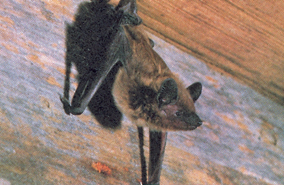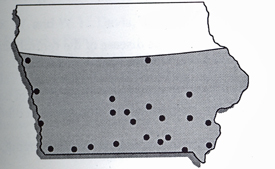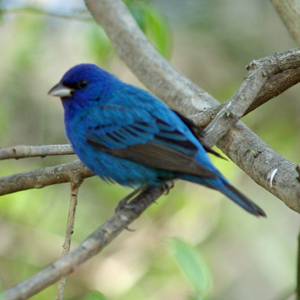Bats of Iowa
Vespertilionidae
Nycticeius humeralis (Rafinesque)
Evening Bat


Etymology
Greek Latin: Nycticeius - "belonging to the night." Latin: humeralis
- "pertaining to the humerus."
Appearance
Fur: Dark brown to blackish, paler below; hair - blackish base, dark
brown tip.
Tail membrane: Blackish; sparsely haired to hairless.
Wing membrane: Blackish; sparsely haired to hairless.
Calcar: Sometimes slightly keeled.
Ears: Short (12 mm); hairless; rounded tip.
Tragus: Clearly less than one-half ear length; rounded tip; curved
forward.
Total length: 93-105 mm. Forearm: 33-39 mm. Wingspan: 260-280 mm.
Total weight: 7-14 g.
Dental formula: 30 total; I 1/3, C 1/1, P 1/2, M 3/3. Other: Upper
incisors separated from canines.
Confusing Species
All species of Myotis: Tragus straight and nearly or more than
one-half ear length; two upper incisors.
Big brown bat (E. fuscus): Larger size (>10 g) and longer forearm
(>40 mm).
Distribution and Status
Overall: Southeastern United States to extreme north-eastern Mexico;
north to latitude of central Iowa and west to longitude of eastern
Nebraska and Kansas. Iowa: Females found in southern two-thirds of
Iowa in summer.
Natural History
Adult female evening bats migrate into southern Iowa by mid-May to
establish nursery colonies of 25 to 500+ individuals in both
woodland and human-made structures. Few adult males have been
reported from the northern part of their range and none from Iowa.
Since sexes segregate in summer, little is known about either mating
or the general reproductive cycle of this bat. While up to four
embryos have been reported, females from Iowa usually carry two.
Most young are born in early June and begin to fly by early July.
The evening bat often emerges early in the evening, frequently
feeding with other species along water courses, forest edges, and in
canopy openings. This species feeds primarily on beetles, moths, and
leafhopppers.
Recent studies in the state suggest that the evening bat is an
important component of the bat fauna of southern Iowa forests but is
absent or rare in northern counties. In woodland sites, small
nursery colonies are established in hollow branches and cavities, as
well as under loose bark. Newly volant young and post-lactating
females utilize several alternate roosts by early July" (Bowles et
al. in press). Evening bats, as well as other forest dwelling
colonial species, may need a critical number of roost trees to
sustain viable populations.


.jpg)
